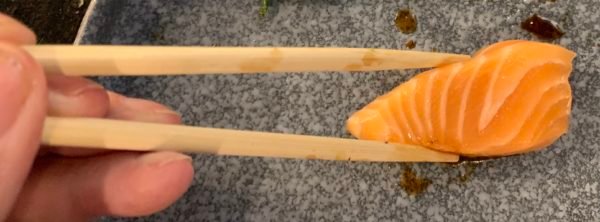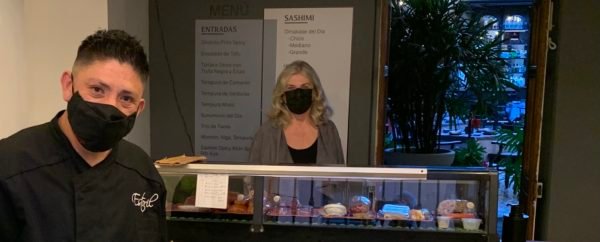Through most of my 18 winters in San Miguel de Allende, finding good sushi has been a battle. And, usually, a losing battle. Those days though may now be over. More and more Mexico City money is coming to town and that money is being used to open new restaurants on an almost weekly basis.
Mexico City adores sushi. There are now over 1,000 sushi bars in the capital and, more and more, those restaurants are serving sushi in the traditional Japanese way, learning that smoked salmon and cream cheese belong on beige bagels, not on white rice.
There have been flashes of good sushi in San Miguel in the past. Chef David Jahnke did some wonderful nigiri on the roof of MX. But that was almost ten years ago. Chef Alberto Ramírez bordered on brilliant with his presentations at the 1826 bar in the Rosewood. But that was five years ago. Now, all of a sudden, our town is blessed with not one but three new Japanese restaurants.
The first is Ryokó on Hernandez Macias. The second is Sai-Ko, again on Hernandez Macias. The third is Murasaki on Hidalgo. So far, the food at Murasaki is in the lead.

A sushi chef is called an itamae. The itamae at Murasaki is called Benito Hernandez. Chef Benito learned the art of sushi (and yes, I believe it’s an art) not in Tokyo, not in Japan, but in Santa Barbara, California, spending eight years at that town’s favorite Japanese haunt. For the last two years, he has worked with the highly-regarded Mexican chef Laura Herrera at Murasaki’s original location in the trendy Colonia Santa Fe district of Mexico City.

As it does in Mexico City, Murasaki shares its real estate with Bistro Estoril, a mid- to high-end restaurant with a cuisine that I can best describe as Mexican/French/International. The location is in the strikingly beautiful Hacienda de Guadalupe on Calle Hidalgo. Murasaki is off to the side, a little lost, and the maitre d’ will probably try to seat you in the main courtyard but insist on a quick left as you enter and you’ll find it.

Sushi is traditionally eaten at lunch (once a week, every week) by Don Day’s Wife and I. We usually share about ten nigiri (the rectangular blocks of rice topped by raw seafood) and two maki (the seaweed wrapped rolls). Occasionally though, we dine on sushi in the evening and, then, we do what we call a feast and what the Japanese call an omakase which very liberally translates as “I’m leaving it all up you, chef”.
Itamaes (back to that word for sushi chefs) generally like doing omakase because, I’ve found, chefs generally like to strut their stuff. This week we left it all up to Itamae Benito Hernandez, asking him to strut his stuff, to serve what he was most proud of.

There are two ways you can approach the request for an omakase. You can ask for a price or, though it’s not always welcomed, you can give the chef your budget. We told Benito Hernandez we had $1500 to spend (with drinks and service extra) and, not only did he seem content with that, he brought us out a much-welcomed, hand-written menu before we even got started.

We ordered a bottle of a drinkable Mexican white called Opuntia that became very drinkable when we found out it was $550 (in a town where it’s becoming more and more difficult to find any bottles under $1000).

Omakase usually starts with a soup, usually a miso. Murusaki started with quickly grilled shishitos, Asia’s only legitimate challenge to Mexico for the world’s best chile title. I like my shishitos well-charred; these weren’t. Don Day’s Wife likes her shishitos well-salted; these were. And Chef Benito’s soy bath had her saying, “that’s what I’m going to do the next time I do shishitos.”

Next was sashimi, the most unadulterated dish in the world of sushi. Just raw fish with a dab of wasabi for heat, a pile of gari or, in English, pickled ginger to cleanse the palate between bites, and a little decoration.
When it comes to seafood, the nose knows. I held the dish under my size XL and then passed it under Don Day’s Wife size M. The smell was what we call fresh ocean air with zero harsh fish odor at all.

I took a piece of rosy hamachi and then some slippery salmon. Don Day’s Wife did the same. The chunks were generous; hard to eat in one bite. It wasn’t just the freshness that was different from the sashimi we were used to, it was the texture.
Here we were in the middle of Mexico. Just a little over three hours from the world’s second largest fish market but a lot more hours from any ocean. And, in case you don’t know, almost all sushi seafood consumed in North America has been previously frozen. I asked Itamae Benito how much of his had been frozen.

“None, no nothing, nothing except the fish roe”, the chef replied. “It’s all bought fresh in Mexico City and shipped here twice each week.”

The next course in the omakase was the nigiri. Like a paella or a risotto, the most important part of nigiri is not the fish but the rice. Unlike a paella or a risotto, the type of rice isn’t important as long as it’s short grain and gets sticky enough to not fall apart when it becomes the foundation for the seafood that’s positioned on top of it.

What goes with the rice when it’s cooked is very important. It’s usually just two things, salt and vinegar. Most chef’s buy commercial vinegar. Benito Hernandez doesn’t. Reaching under the counter, he pulled out a beat-up old plastic jug.

“I make my own”, he said.

The chef slick-sliced with his, of course, “Made in Japan” knife and was light-handed with the amount of wasabi. “You can always add your own.” And, as each piece of nigiri is meant to be eaten in one bite, sizing was perfect.

Next up was the maki, the roll. There’s always an argument between tradition and fusion when it comes to maki. Murasaki doesn’t stray too far. The tuna and salmon were torched, which I’m never sure adds that much to a roll but is a nice spectator sport. The other two nuances though were very nice.
Instead of nori, the seaweed that is traditionally used to wrap a maki, Chef Benito used something he called soy paper. Maybe all maki should be wrapped with soy paper. Then he topped our roll with something we’d never seen used before, even though the French have paired it with fish for centuries. Slivered, roasted almonds worked wonderfully.

We had one course left. Dessert. Japanese restaurants have, possibly…no, make that probably, the world’s worst desserts and I usually dread that stemmed bowl of green tea ice cream that ultimately shows up at the end of an omakase.

Benito Hernandez may also read minds. A crème brulée, one of the world’s best desserts, was brought from Murasaki’s sister kitchen at Estoril.

I will give the final word to the quality of the food to Don Day’s Wife: “This was the best sushi we have ever had, ever in our lives, in Mexico”. I will add that at $2500, including a generous tip, it was far from our most expensive omakase.

As good as the food was, though, the restaurant has a ways to go.

Sushi restaurants should always have open kitchens; somebody decided to stick Musaraki’s in the entranceway. Murasaki’s light level is what you might expect at an operating room table not a dining room table. I like Willie, Waylon and Merle as much as those guys who wear uncomfortable footwear but country and western in a Japanese restaurant? The servers get an A for looking good and a B for effort but an E for those plates covered in shishito stems that we were still using three courses later. And, when you’re training staff, perhaps start by telling them what Murasaki means so I don’t have to explain to them about the importance of the color purple.
Anyway, many of those problems were hopefully just early days jitters and we can handle a few starting jitters as long as they’re not never-ending jitters. Murasaki is now our place for our once a week every week sushi and once in a while extravagant omakase.
Winters in Mexico just became that more wonderful.

Murasaki is located at Hidalgo #4 in San Miguel de Allende, Mexico. The restaurant is open from 1:00 to 10:30 pm, Sunday and Monday; Wednesday to Saturday, 1:00 pm to Midnight.


Hola, a very good education on sushi terminology… much appreciated. PS: I have not had sushi since SE ASIA, never in Mexico. Your article gave me confidence to consider it in Mexico. Thanks,
I have eaten there twice in the last week–think it’s fabulous! a special surprise is the wonderful Mexican wine–and the Chocolate Mousse!!! oh My!
thanks for the great thorough review!!
Wow! This town is getting expensive. Too much for my budget.
Wonderful review. Would appreciate phone numbers for making reservations.
What are the street numbers for the first two? Again, many thanks.
Marge
We have been to Ryoko and it is the best sushi that we have had outside of Japan. For several years, Donnie’s sushi bar at The Restaurant has been our go-to for sushi (about once a week prior to and after the pandemic, even delivery several times during). Prior to Ryoko, we said that Donnie’s sushi was the best sushi that we have had outside of Japan and our view is that it is only slightly less impressive than Ryoko. And the ambience at Donnie’s sushi bar is outstanding, what a beautiful bar and setting. The service is excellent – we prefer to sit at the bar when we have sushi but there are several tables as well. Donnie’s prices are about 50% less than Ryoko (more in line with what you describe for Murasaki) so it’s still our go-to for sushi.
Had lunch with a friend at Estoril and ordered from the (extensive) sushi menu. Excellent service, beautifully plated tempura starter and large makis. No problem with the lighting in the main restaurant space — they even adjusted the ceiling (moveable) when the sun moved to our table at lunch.
We will be back.
hi Glenn, great review, and now i must try Murasaki. Question, did Chef Hernandez mention how he preps his raw fish to make it safe for consumption? i crave Salmon Sashimi, but it can contain parasites. i have found there’s no flash freezing process to rid raw fish of parasites and unwanted bacteria in the other 2 sushi restaurants you mentioned in this review. do you know what / if Murasaki does to make it safe to eat raw fish?
I’m far from an expert and almost all of my sushi experience is Toronto-based. We generally don’t worry about raw salmon if it’s farmed and, because of price, it’s rare we see any wild in sushi bars. That’s based on a belief that farmed is generally free of parasites but I’m not sure that’s true. I know that some people stay away from mackerel due to parasite risk; I just take my chances there. Murasaki didn’t serve mackerel at the omakase but I have ordered it there on another occasion.
Re what you mentioned up top about cream cheese belonging on a bagel? I couldn’t agree more….but That’s what I received, in a salmon roll, when we asked the waiter to choose his top 3 picks. I guess that’s what you get for doing that. I was underwhelmed, but I’ll go back and try again, this time being more specific…. My fault, I guess.